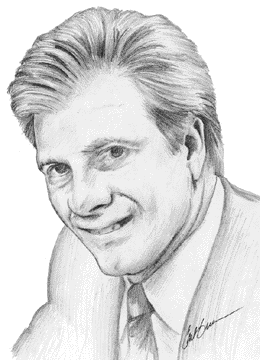INTERVIEW
From The Pit To The PC
Lewis J. Borsellino
ILLUSTRATION BY CARL GREEN
Did your trading career begin in the Standard & Poor's pit?
No, my trading career began in the gold futures pit. At one time, the
Chicago Mercantile Exchange's gold pit was the largest and traded the most
volume of gold contracts. At that time, gold was trading over $800 per
ounce. One day, I was playing racquetball with a trader and I asked him
if I could open an account to trade gold futures. He suggested I come down
to the exchange and see what it was like. He didn't want me to just open
up an account, he said, because I didn't know what I was doing and I would
just be throwing my money away. The moment I walked out on the trading
floor, though, I thought it was the greatest thing I ever saw in my life.
So you arranged to get a seat?
I was a runner for about two months. Fortunately for me, I met Maury
Kravitz, who was a very successful gold trader. I introduced myself to
him. My mother had been his legal secretary for about 15 years. As it so
happens, at the time, he had a young law clerk whom he had got started
in the business, Jack Sandner, who years later became the chairman of the
Merc.
Interesting twist of fate.
It was. When I introduced myself to Maury, he looked at me and asked
why I hadn't called him for a job. I said I hadn't wanted to bother him.
He said I had a job in two weeks.
Just like that! What happened?
He made me his assistant in the gold pit two weeks later. I did that
for about a year, and then he sponsored me for a seat.
So you were assisting as a clerk?
That's right. Back then, the arb wasn't as big [Editor's note:
"arb" is the hand-signaling of orders to floor brokers in the pit], and
we had a huge deck. I was the clerk who managed the deck.
So you started out as a local in the gold pit?
I was just assisting Maury. Then he helped me get a membership, and
I started filling orders and trading my own account.
And how did that go?
Not well. Every trader has to go through a learning process, and I
went through mine. The mistakes were eating me alive. About six or seven
months into it, I ran out of money. I hadn't made any money because the
gold market had abruptly switched from a bull market to a bear market.
It went from over $800 to about $330. During the Falklands War in 1982,
there was a peace scare, and gold had a $50 range. I was checking a trade
with another trader, and we realized that we had an out trade where we
had made nearly $60,000 each.
And then what?
A month later, the S&P pit opened up, and I said to Maury that
I thought this was going to be a good pit. I suggested that we get a deck
in there and do some business, and we did.
And so obviously that worked out.
In trading the S&P, we started to get the customers that we had
had in the gold market. The pit grew every day. The volume grew, and the
bull market was just getting started. I remember that the Dow Jones Industrial
Average (DJIA) was below 1,000 when we started that contract. By the time
we went through the 1,000 level, it was clear that the S&P was going
to be big. I grew my business, and by 1986, I had the largest deck in the
pit and had become the biggest trader.
I found that people who were traders are good traders, and people who were chartists are good chartists. It doesn't mean that a chartist can be a good trader. -- Lewis Borsellino
Excerpted from an article originally published in the July 1999 issue of Technical Analysis of STOCKS & COMMODITIES magazine. All rights reserved. © Copyright 1999, Technical Analysis, Inc.
